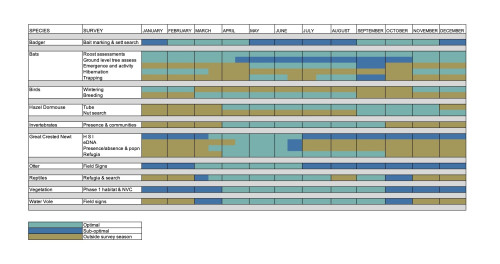Understanding Ecology & It’s Timeframes for your residential project
28 October 2024 by Andrew Pizzey
Old browser alert! We have detected you are using a pretty old browser. This website uses cool features that can't be supported by your browser.
If we let you see the website it would look all weird and broken, nobody wants that!
Update your browser!28 October 2024 by Andrew Pizzey

Ecology is playing an increasingly significant role in the built environment. With a growing awareness of delicate ecosystems, local authorities are commonly requiring ecological surveys as part of planning applications. On a larger scale, new regulations with regards to Biodiversity Net Gain (BNG) came into effect in February 2024. Initially, these rules applied only to major developments in England, requiring them to achieve a 10% biodiversity net gain. Starting in April 2024, these requirements were expanded to smaller developments, with Nationally Significant Infrastructure Projects (NSIPs) expected to be included by 2025.
Ecology encompasses all the plant and animal life on a site and within its surrounding environment. In construction, it refers to practices aimed at reducing environmental impact during the design and construction of buildings.

While some might view ecology as merely a checkbox exercise in the planning process, it should be a fully integrated part of the project’s approach from start to finish. Early site visits are crucial to identify any ecological concerns, and if an ecology consultant may need to be appointed to conduct the necessary surveys.
An ecological survey assesses the potential environmental impact of a proposed development on local ecosystems. It involves identifying any protected species, such as bats or Great Crested Newts, that may inhabit the site and evaluating the types of habitats present, like woodlands or wetlands, to determine their ecological value. These surveys also consider how a development may affect local wildlife and plant species, focusing on risks to biodiversity. Based on the findings, it provides recommendations to mitigate negative impacts, such as preserving habitats or creating new ecological features. Ultimately, the survey explains how the project can comply with environmental regulations and planning requirements, guiding the design and construction process to minimise harm to the environment.
When embarking on a new project, it’s important to determine which surveys are required. A useful tool for exploring this is the local authority’s “Biodiversity and Ecology Checklist” (though the name may vary by authority). These checklists help identify the types of surveys needed for the project.
For residential projects, two common surveys are for bats and Great Crested Newts. For instance, Waverley Borough Council’s checklist outlines various criteria—such as proximity to forests or bodies of water and the type of materials used in the existing building e.g. hung tile—to help determine if a survey is necessary. If unsure, it’s advisable to consult the local planning department or review previous planning applications in your area through your authority’s planning search tool.

Certain ecological surveys can only be conducted during specific times of the year. The visual guide we share below illustrates a rough optimal, sub-optimal, and off-season period for various surveys.
For example, bat surveys—commonly required for domestic projects—have a specific window during which emergence and activity surveys can be conducted, typically from May to September. Understanding these timeframes can help anticipate potential delays or determine the urgency for completing ecological surveys.

Here are four essential points to integrate ecology into your project seamlessly, rather than it causing delays: